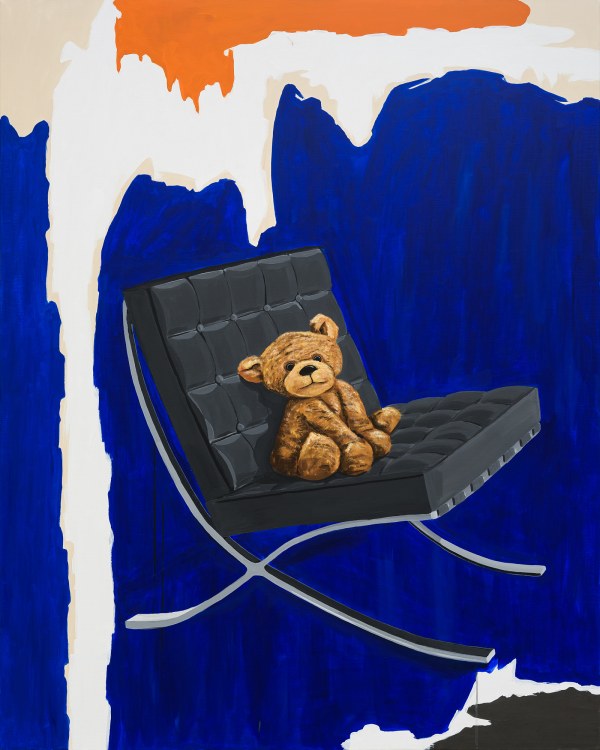Djordje Ozbolt: Greetings from a Far Away
Gallery Baton is pleased to present Djordje Ozbolt’s solo exhibition Greetings From A Far Away from November 28th, 2019 to January 3rd, 2020. Constantly exploring a variety of mediums including drawing, painting, and sculpture, Djordje Ozbolt(b. 1967), who successfully held the Pavilion of Serbian at the 58th Venice Biennale this year, has gained global reputation for his unique works. Following the first exhibition at Gallery Baton in 2017, this second exhibition aims to showcase a selection of new works embodying the artist’s playful and witty, yet truly individualistic sense of humour.
Having spent his early childhood years in Yugoslavia where the atrocities of social conflicts and civil insurgencies persisted, he subsequently settled down in London, the center of European culture and established his artistic career for the past 30 years. Such an acknowledgement of Ozbolt’s personal account sheds light on his emotional sensibilities and artistic perspective that he embedded into his works. Henceforth, his personal reinterpretations of a subject matter—whether it be issues from current events, an extraction from the media, acquaintances of new cultures during his worldwide travels, or even ordinary content excerpted from his massive private collections of nonfiction books—take on a whole new approach on his canvas. This further enables the medium of 'painting,' which has often been seen as a more traditional form of activity, to undertake creative and experimental possibilities for artistic expression.
What most stands out in his work is the emergence of eccentric imaginative imageries. In his paintings and sculptures often portray unfamiliar backdrops imbued with animals, objects, and human characters that conduct themselves in rather unforeseen behaviors. In this exhibition, spectators would encounter depictions of an azure camel standing boldly on the grounds of an extrasolar planet, a humanlike palette, or even a monkey admiring a sculpture. These paintings are further characterized by a sense that all creatures are fully aware of the spectators’ gaze and presence. The application of this mise-en-scène and landscape as a background was intended to be full of meaning. For example, a composition he frequently uses borrows from the techniques of ‘traditional painting’ that prevailed before the Modernist movement, emphasized the naturalistic representation of figures and narratives. This specific style becomes a means of assigning a formal status and personified image to his illustrated subjects. By breaking the traditional norms, Ozbolt recalls various components emanating from different art movements—Primitive Art, Cubism, Realism, and Surrealism—hence making it impossible to define his works into a single category. This extreme stance, therefore, enables the artist to generate a disharmonious composition that has successfully shaped a new paradigm for his artistic style.
Ozbolt rejects any given formalities for representation and subverts ordinary conventions and practices. By distorting the relationships between characters and objects, he produces a sense of alienation and displacement, as well as seeks disorder within his investigation of the correspondence between the provisions and laws of nature. The layering of multiple elements and spaces results in an unreal, supernatural world that operates in the same way as a psychedelic hallucination, thus outstripping the unidimensional level of our imagination. Within these surprising combinations of objects and icons, notions of order and disorder coexist paradoxically. At this point, his key subject for the 'aesthetic of incongruity' is vividly revealed in his works through such measures. However, Ozbolt manages to captivate the viewers’ attention and share his surrealistic sensitivity through the distinct style which configuration is an mismatched yet tension, grotesque setting and inimitable artistic sense.
La Vida Loca (2019), for instance, depicts a multicolored ostrich posing to expose its graceful aura. Interestingly, the image reminds us of the biologist, Alfred Russel Wallace’s discovery of the 'Bird of Paradise' species. He had once lamented that “... For a long time, this little living thing has repeatedly come into being and passed away in the midst of a dark and gloomy forest, without anyone noticing its exquisite magnificence…” This iteration eventually aligns with Ozbolt’s portrayal of the ostrich, yet such a peculiar-looking creature would not exist in reality if we were to align with our logical and generic beliefs. Nevertheless, Ozbolt throws us a question: what does the chair that we think of truly look like among Joseph Kosuth’s One and Three Chairs (1965)? In the work, Kosuth represents a single chair in three different ways—composed of an image, an object, and in words. By applying this same conceptualization, the open-ended question by artist ‘Could one simply declare that such a polychromatic ostrich does not exist in reality?’ recalls the 17th century’s discovery of the Black Swan also raised similar questions, leaving Europeans in shock. These instances invite us to think twice about the boundaries existing between conception, imagination, and reality.
Djordje Ozbolt studied artchitecture at School of Architecture at University of Belgrade, Belgrade, received a BA in Fine Art from Slade School of Fine Art, London and an MA in Painting from Royal Academy of Art, London. He has held solo exhibitions including Gallery Baton, Seoul (2017); the Holburne Museum, Bath (2016) and has participated in group exhibitions at international major museums and art institutions such as Tate Britain, London (2006), Zabludowicz Collection, London (2010); National Museum of Art, Osaka (2012); Hudson Valley Center for Contemporary Art, Peekskill (2015); New York White Columns (2005) and etc.
-
 Djordje OzboltOn the Cliff, 2019
Djordje OzboltOn the Cliff, 2019 -
 Djordje OzboltAccidental Meeting, 2019
Djordje OzboltAccidental Meeting, 2019 -
 Djordje OzboltThree Times Lucky, 2019
Djordje OzboltThree Times Lucky, 2019 -
 Djordje OzboltLonely, 2019
Djordje OzboltLonely, 2019 -
 Djordje OzboltLook Out, 2019
Djordje OzboltLook Out, 2019 -
 Djordje OzboltGreatness of Critical Mass, 2019
Djordje OzboltGreatness of Critical Mass, 2019 -
 Djordje OzboltAfter Rain, 2019
Djordje OzboltAfter Rain, 2019 -
 Djordje OzboltMusic of the Forest, 2019
Djordje OzboltMusic of the Forest, 2019 -
 Djordje OzboltDesert Blues, 2019
Djordje OzboltDesert Blues, 2019 -
 Djordje OzboltPainter's Pet, 2019
Djordje OzboltPainter's Pet, 2019 -
 Djordje OzboltSun Spots, 2019
Djordje OzboltSun Spots, 2019












